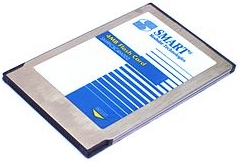The PC (PCMCIA) Card
By Stephen Bucaro
The PC card, technically called the PCMCIA Card because it was developed by the Personal
Computer Memory Card International Association, is a form factor of a peripheral interface
designed for laptop computers.

It was originally designed for computer memory expansion, but it became a standard for
other notebook computer peripherals including network cards, modems, hard disks, and digital cameras.
A PCMCIA Card is 85.6 mm long by 54 mm wide but come in three different types,
each with a different thickness.
| Type | Interface | Thickness |
| I | 16-bit | 3.3 mm |
| I | 16-bit or 32-bit | 5.0 mm |
| III | 16-bit or 32-bit | 10.5 mm |
There was also a Type-IV card released by Toshiba that is not an official PCMCIA standard,
that is 16 mm thick.
The original standard was defined for both 5 volt and 3.3 volt cards. The 3.3 V cards have
a key on the side to prevent them from being inserted fully into a 5 V-only slot.
Today PCMCIA card is a legacy interface, as devices that used PCMCIA now use the USB interface.
More Computer Anatomy Articles:
• A Guide to Basic PC Cooling
• How a laser Printer Works
• How to Build Your Own PC - The Smart Way
• MPEG4, H.264, MJPEG Compression for DVR Recording - What's the Difference?
• All About Your Computer's BIOS
• Anatomy of a Hard Drive
• Understanding Computer Memory
• Basic Computer Thermodynamics
• How Hard Disks Work
• The Master Boot Record (MBR)
| 
